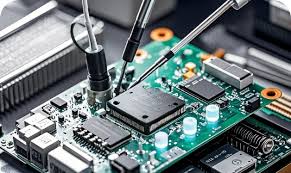Are you tired of feeling like a lost soul in the labyrinth of buttons and symbols on your calculator? Well, fear no more! It’s time to demystify these little magical machines and unlock their secret powers. In this blog post, we will take you by the hand and guide you through understanding the basics and functions of calculators. Whether you’re a student struggling with math or just someone who wants to sharpen their number-crunching skills, get ready for an enlightening journey into the world of calculators.
Introduction to Calculators
A calculator is a device that is used to perform mathematical calculations. There are many different types of calculators available, each with its own unique set of features and functions. The most basic type of calculator can perform addition, subtraction, multiplication, and division. More advanced calculators can also perform more complex operations such as square roots and exponentiation.
Calculators can be very useful tools for both students and professionals. Students can use them to help with their homework and studies, while professionals can use them for tasks such as balancing their budget or calculating payroll. No matter what your needs are, there is sure to be a calculator out there that is perfect for you!
What is a Calculator?
A calculator is a small, handheld electronic device used to perform mathematical calculations. They are typically powered by batteries, and most can be used to perform basic arithmetic operations such as addition, subtraction, multiplication, and division. Some calculators also have more advanced features, such as square roots and exponential functions.
Different types of calculators
There are different types of calculators for different purposes. The four main types of calculators are:
1. Basic calculators: These are the simplest types of calculators and are usually used for addition, subtraction, multiplication, and division.
2. Scientific calculators: These calculators have more features than basic calculators and can be used for more complex mathematical operations such as trigonometric functions and logarithms.
3. Financial calculators: These calculators are designed to help with financial calculations such as interest rates, investment growth, and annuities.
4. Graphing calculators: These calculators can plot equations and graph data points on a coordinate plane. They are often used in science and engineering courses.
Benefits of Using a Calculator
When it comes to math, a calculator can be a helpful tool. It can help you solve equations and do complex calculations quickly and easily. Here are some of the benefits of using a calculator:
1. You can save time by using a calculator to do complex calculations instead of doing them by hand.
2. A calculator can help you check your work for mistakes and correct them before turning in your assignment.
3. You can use a calculator to explore different solutions to a problem, which can help you understand the concept better.
4. A calculator can help you visualize mathematical concepts, which can make them easier to understand.
5. You can use a calculator to solve problems that you wouldn’t be able to solve by hand, such as large equations or problems with multiple variables.
Basic Calculator Functions and Uses
Calculators are often used to perform basic arithmetic operations such as addition, subtraction, multiplication, and division. In addition to these basic functions, most calculators also have more advanced functions that can be used for more complex calculations.
To use a calculator, you first need to understand the different buttons and what they do. The number buttons (0–9) are used to enter numbers into the calculator. The +, -, x, and ÷ buttons are used for addition, subtraction, multiplication, and division, respectively. The = button is used to calculate the answer.
There are also a few other buttons that are useful to know about. The clear or C button clears the last entry or all entries on the calculator. The memory, or M, button stores numbers in memory so that they can be accessed later. The recall, or R, button recalls numbers from memory. And finally, the percent or % button calculates percentages.
Now that you know the basics of using a calculator, let’s look at some examples of how they can be used in real life.
One common use for a calculator is figuring out the sales tax on an item. To do this, you first need to know the sales tax rate in your area. Let’s say the sales tax rate is 7%. To calculate the sales tax on an item that costs $100, you would multiply $100 by 0.07 to get $7. So the total cost of the item would be $107.
Calculators can also be used to solve equations. For example, if you are trying to find the value of x in the equation 2x + 6 = 10, you would enter 2x + 6 = 10 into the calculator and press the = button. The answer will be x = 2.
Finally, calculators can be used to help with budgeting. By entering your expenses and income into a calculator, you can easily figure out how much money you have left over each month and make better decisions about your spending habits.
Advanced Calculator Functions and Uses
Advanced calculator functions can seem daunting, but they are actually quite simple once you understand the basics. There are many different types of advanced calculator functions, but they all serve the same purpose: to help you perform calculations more efficiently.
The most common type of advanced calculator is the scientific calculator. Scientific calculators have more buttons and options than a standard calculator, but they are still relatively easy to use. The extra buttons on a scientific calculator allow you to perform more complex calculations, such as trigonometric functions and exponential operations.
Another common type of advanced calculator is the graphing calculator. Graphing calculators are similar to scientific calculators, but they also have a small screen that can display graphs and charts. Graphing calculators are often used by students in math and science classes to visualize data and concepts.
There are also financial calculators, which are designed to help you with budgeting, investment decisions, and other financial planning tasks. Financial calculators usually have features that allow you to input variables such as interest rates and inflation rates so that you can see how these factors will affect your bottom line.
There are programmable calculators that allow you to store equations or sets of data for later use. Programmable calculators are often used by scientists and engineers who need to perform complex calculations on a regular basis.
Tips for Choosing the Right Calculator
When it comes to choosing the right calculator, there are a few things you need to take into account. Here are some tips to help you make the best choice:
What is the purpose of the calculator? Do you need it for simple mathematical operations or for more complex calculations?
How easy is it to use? Some calculators have more features than others, which can make them more difficult to use. Make sure you choose a calculator that is easy for you to understand and use.
How portable does it need to be? If you need a calculator that you can take with you everywhere, then you will need to choose a smaller, more portable option. However, if size is not an issue, then you can opt for a larger model.
What is your budget? Calculators come in a wide range of prices, so be sure to choose one that fits your budget.
Conclusion
Calculators can be incredibly useful tools for solving problems quickly and accurately, but they’re not always easy to understand. We hope this article has helped demystify calculators and given you a better understanding of their basic functions. With the knowledge from this article, you should now feel more confident operating a calculator and tackling math-based tasks with ease.



































